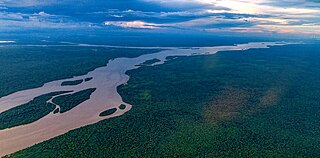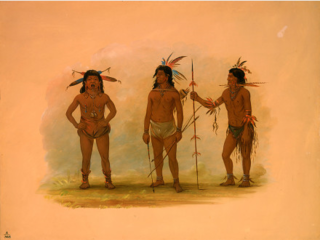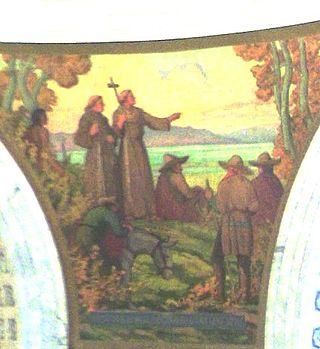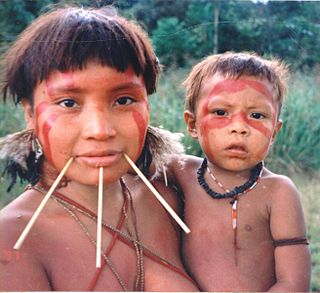
Francisco de Orellana Bejarano Pizarro y Torres de Altamirano was a Spanish explorer and conquistador. In one of the most improbably successful voyages in known history, Orellana managed to sail the length of the Amazon, arriving at the river's mouth on 24 August 1542. He and his party sailed along the Atlantic coast until reaching Cubagua Island, near the coast of Venezuela.

Amazonas is a state of Brazil, located in the North Region in the northwestern corner of the country. It is the largest Brazilian state by area and the 9th largest country subdivision in the world, and the largest in South America, being greater than the areas of Uruguay, Paraguay, and Chile combined. Mostly located in the Southern Hemisphere, it is the third largest country subdivision in the Southern Hemisphere after the Australian states of Western Australia and Queensland. Entirely in the Western Hemisphere, it is the fourth largest in the Western Hemisphere after Greenland, Nunavut and Alaska. It would be the sixteenth largest country in land area, slightly larger than Mongolia. Neighbouring states are Roraima, Pará, Mato Grosso, Rondônia, and Acre. It also borders the nations of Peru, Colombia and Venezuela. This includes the Departments of Amazonas, Vaupés and Guainía in Colombia, as well as the Amazonas state in Venezuela, and the Loreto Region in Peru.

Darkness in El Dorado: How Scientists and Journalists Devastated the Amazon is a polemical book written by author Patrick Tierney in 2000, in which the author accuses geneticist James Neel and anthropologist Napoleon Chagnon of conducting human research without regard for their subjects' well-being while conducting long-term ethnographic field work among the indigenous Yanomamö, in the Amazon Basin between Venezuela and Brazil. He also wrote that the researchers had exacerbated a measles epidemic among the Native Americans, and that Jacques Lizot and Kenneth Good committed acts of sexual impropriety with Yanomamö.

El Dorado is commonly associated with the legend of a gold city, kingdom, or empire. Originally, El Hombre Dorado or El Rey Dorado, was the term used by the Spanish in the 16th century to describe a mythical tribal chief (zipa) or king of the Muisca people, an indigenous people of the Altiplano Cundiboyacense of Colombia, who as an initiation rite, covered himself with gold dust and submerged in Lake Guatavita.

The Rio Negro, or Guainía as it is known in its upper part, is the largest left tributary of the Amazon River, the largest blackwater river in the world, and one of the world's ten largest rivers by average discharge.

The Essequibo River is the largest river in Guyana, and the largest river between the Orinoco and Amazon. Rising in the Acarai Mountains near the Brazil–Guyana border, the Essequibo flows to the north for 1,014 kilometres (630 mi) through forest and savanna into the Atlantic Ocean. With a total drainage basin of 156,828 square kilometres (60,552 sq mi) and an average discharge of 4,531–5,650 cubic metres per second (160,000–199,500 cu ft/s).

The Omagua people are an indigenous people in Brazil's Amazon Basin. Their territory, when first in contact with Spanish explorers in the 16th century, was on the Amazon River upstream from the present-day city of Manaus extending into Peru. They speak the Omagua language. The Omagua exist today in small numbers, but they were a populous, organized society in the late Pre-Columbian era. Their population suffered steep decline, mostly from infectious diseases, in the early years of the Columbian Exchange. During the 18th century, the Omagua largely abandoned their indigenous identity in response to prejudice and racism that marginalized aboriginal peoples in Brazil and Peru. More tolerant attitudes led to a renewed tribal identity starting in the 1980s.
Uakti is a mythical musician described by the Tucano people of the Alto Rio Negro region of the Amazon. According to the legend, the creature had holes in his body such that they would produce sound when he ran or the wind blew through him. This music seduced the women of the tribe and so the other men burned and buried his body. The myth holds that out of Uakti's remains grew the palm trees from which the Tukanos' flutes are made. The women of the Tukano Indians are thus not allowed to play flutes.

Davi Kopenawa Yanomami, name also written Davi Kobenawä Yanomamö, is a Yanomami shaman and Portuguese-speaking spokesperson for the Yanomami People in Brazil. He became known for his advocacy regarding tribal issues and Amazon rainforest conservation when the tribal rights organization Survival International invited him to accept the Right Livelihood Award on its behalf in 1989. In 2019, Yanomami and the Hutukara Yanomami Association were also awarded the Right Livelihood Award. Yanomami spoke to both the British and Swedish parliaments about the catastrophic impact on Yanomami health as a consequence of the illegal invasion of their land by 40,000 ‘garimpeiros’ or goldminers. Prince Charles publicly called the situation ‘genocide’. In a seven-year period from 1987 to 1993 one fifth of the Yanomami died from malaria and other diseases transmitted by the miners.

The Domínguez–Escalante Expedition was a Spanish journey of exploration conducted in 1776 by two Franciscan priests, Atanasio Domínguez and Silvestre Vélez de Escalante, to find an overland route from Santa Fe, New Mexico, to their Roman Catholic mission in Monterey, on the coast of modern day central California. Domínguez, Vélez de Escalante, and Bernardo de Miera y Pacheco, acting as the expedition's cartographer, traveled with ten men from Santa Fe through many unexplored portions of the American West, including present-day western Colorado, Utah, and northern Arizona. Along part of the journey, they were aided by three indigenous guides of the Timpanogos tribe.
The Lost City of Z is the name given by Col. Percy Harrison Fawcett, a British surveyor, to an indigenous city that he believed had existed in the jungle of the Mato Grosso state of Brazil. Based on early histories of South America and his own explorations of the Amazon River region, Fawcett theorized that a complex civilization once existed there, and that isolated ruins may have survived.
Theodor Koch-Grünberg was a German ethnologist and explorer who made a valuable contribution to the study of the Indigenous peoples in South America, in particular the Pemon of Venezuela and other indigenous peoples in the Amazon region extending South-Western Brazil and a large part of the Vaupés region in Colombia. The 2015 film El abrazo de la serpiente fictionalizes his illness and final days based on his journals. He was played by actor Jan Bijvoet.

Novo Airão is a municipality located in the state of Amazonas in northern Brazil on the Rio Negro River about 180 km upstream of Manaus. Its population was 19,928 (2020) and its area is 37,771 km². The town is reachable both by river and road.
Gregory Deyermenjian is a psychologist and explorer. In 1981 he visited the ruins of Vilcabamba la Vieja at Espíritu Pampa, and then turned his attention to the northeast and north of Cusco, Peru. Since the mid-1980s he has made numerous expeditions to Peru investigating Paititi, a legendary lost city that is part of the history and legend of the western Amazon basin. He is a long-term Fellow of The Explorers Club.

The Yanomami, also spelled Yąnomamö or Yanomama, are a group of approximately 35,000 indigenous people who live in some 200–250 villages in the Amazon rainforest on the border between Venezuela and Brazil.

Lake Parime or Lake Parima is a legendary lake located in South America. It was reputedly the location of the fabled city of El Dorado, also known as Manoa, much sought-after by European explorers. Repeated attempts to find the lake failed to confirm its existence, and it was dismissed as a myth along with the city. The search for Lake Parime led explorers to map the rivers and other features of southern Venezuela, northern Brazil, and southwestern Guyana before the lake's existence was definitively disproved in the early 19th century. Some explorers proposed that the seasonal flooding of the Rupununi savannah may have been misidentified as a lake. Recent geological investigations suggest that a lake may have existed in northern Brazil, but that it dried up some time in the 18th century. Both Manoa and Parime are believed to mean "big lake".

The Lost City of Z: A Tale of Deadly Obsession in the Amazon is a non-fiction book by American author David Grann. Published in 2009, the book recounts the activities of the British explorer Percy Fawcett who, in 1925, disappeared with his son in the Amazon rainforest while looking for the ancient "Lost City of Z". In the book, Grann recounts his own journey into the Amazon, by which he discovered new evidence about how Fawcett may have died.
Lawrence Kemys or Keymis was an English seaman and companion of Sir Walter Raleigh in his expeditions to Guiana in 1595 and 1617–18.

The Discovery of Guiana is a book by Sir Walter Raleigh, who wrote this account one year after his 1595 journey to Guiana, the Venezuelan region of Guayana. He also visited Trinidad. The book includes some material of a factual nature, but postulates the existence of a gold-rich civilisation on the basis of little evidence.

Raleigh's El Dorado expedition, also known as Raleigh's first voyage to Guiana, was an English military and exploratory expedition led by Sir Walter Raleigh that took place during the Anglo-Spanish War in 1595. The expedition set out in February 1595 to explore the Orinoco River on the northeast tip of South America in an attempt to find the fabled city of El Dorado.














